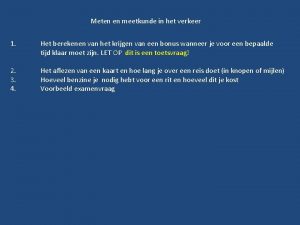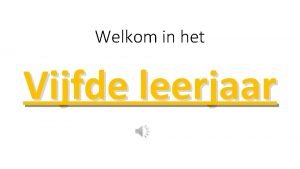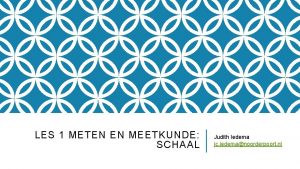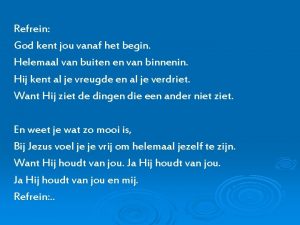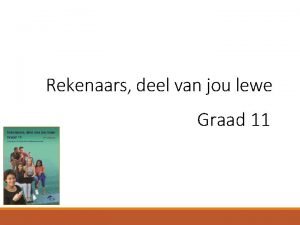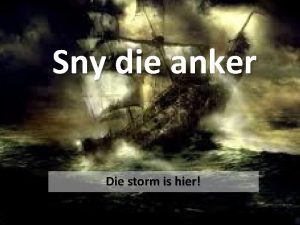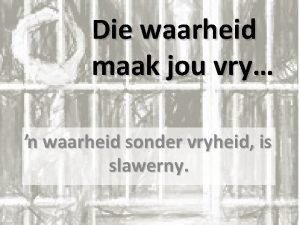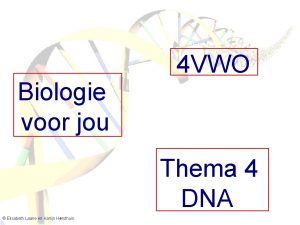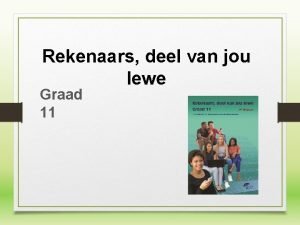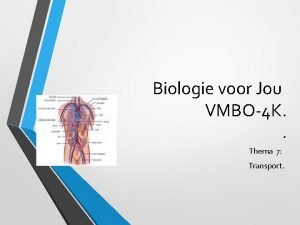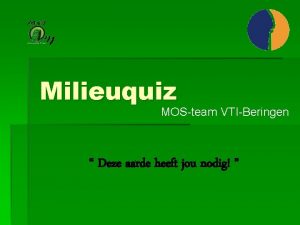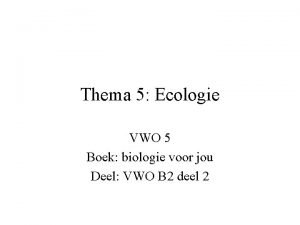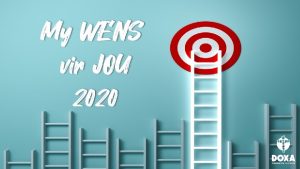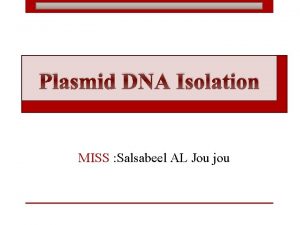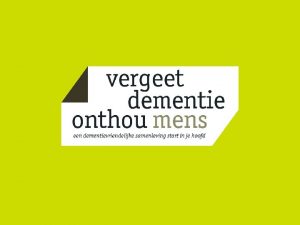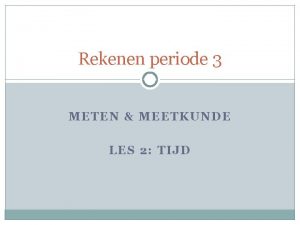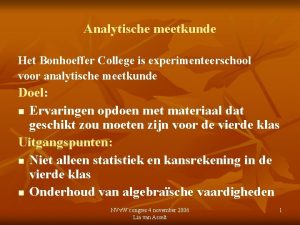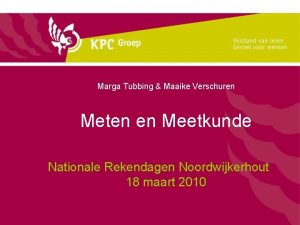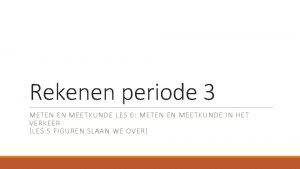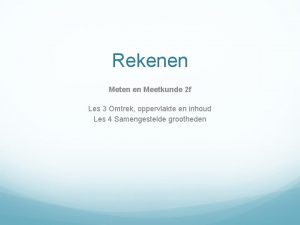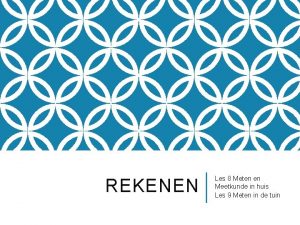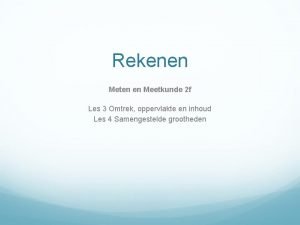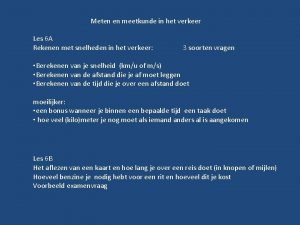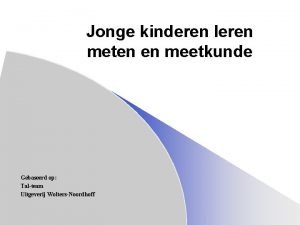Onthou om jou mikrofoon af te sit Meetkunde


















- Slides: 18

Onthou om jou mikrofoon af te sit Meetkunde en Tegnologie Sessie 6 SBIDZ Open Saldanha Tegnologie in die onderrig van Wiskunde Aanlyn kursus

Looking back Tools determine reasoning o o o Affordances and constraints of the tool for meaningful learning o Advantages of using a dynamic tool o Geometric habits of mind for the 21 st century Session 2: You cannot believe your eyes. Reason! Session 3: Constructions of a square: transformation tools, drag test Group reflection on DBE Use of Technology in schools Session 4: Triangle sum constructions Session 5: Equivalence, congruence GSP skills • Constructing and drawing figures • Constructing lines perpendicular to and parallel to another line • Labelling and marking sides, vertices and angles • Measuring side lengths and angles • Transform figures: rotation, reflection, translation 2

Where are we in relation to the curriculum? 3

Where are we in relation to the curriculum? 4

5

6

Sir Roger Penrose- Nobel Prize Laureate 2020 7

8

9

The focus in Senior Phase is “write clear definitions (Grade 8), once “compare”isons were made between properties of figures (Grade 7). The progression to Grade 9 is not in terms of content, but in terms of proof-reasoning. The teacher’s task is to make connections between the content bullets, not to teach the content as a list: How are triangles related to quadrilaterals? How can we use triangle properties to reason about quadrilateral properties? 10

Session 6: Reasoning with dynamic constructions: Properties of quadrilaterals (polygons) Session outline • 16: 00 – 16: 30 From triangles to polygons: constructing and defining • 16: 30 – 17: 00 Defining and classifying • 17: 00 – 17: 30 From visual exploration to proof reasoning: midpoints of sides of quadrilaterals 11

Big ideas • Reasoning with transformations • Building quadrilaterals (polygons) from triangles • Breaking up quadrilaterals (polygons) into triangles • Patterns (symmetry) • Definitions are arbitrary, but give rise to different deductive systems Hence, it makes sense that • Deep understanding of triangle properties is a key aspect of the geometry curriculum • Progression is based on developing proof reasoning 12

Constructing and Defining Definitions are arbitrary/ Definisies is arbitrêr Descriptive defining/ Beskrywende definiëring: • ". . . the describing definition. . . outlines a known object by singling out a few characteristic properties". - Hans Freudenthal (1973 : 458) • With the descriptive (a posteriori) defining of a concept is meant here that the concept and its properties have already been known for some time and is defined only afterwards. A posteriori defining is usually accomplished by selecting an appropriate subset of the total set of properties of the concept from which all the other properties can be deduced. This subset then serves as the definition and the other remaining properties are then logically derived from it as theorems. Our goal in SENphase if • Constructive defining/ Konstruktiewe definiëring descriptive definition • ". . . the algorithmically constructive and creative definition. . . models new objects out of familiar ones" - Hans Freudenthal (1973 : 458). • Constructive (a priori) defining takes places when a given definition of a concept is changed through the exclusion, generalization, specialization, replacement or addition of properties to the definition, so that a new concept is constructed in the process In other words, a new concept is defined "into being", the further properties of which can then be experimentally or logically explored. • Whereas the main purpose or function of a posteriori defining is that of the systematization of existing knowledge, the main function of a priori defining is the production of new knowledge. (Go to GSP: Session 6) 13

Defining and Classifying/Definiëring en klassifisering • Van Hiele 1: Visual definitions, e. g. a rectangle is a quad that looks like this (draws or identifies one) or describes it in terms of visual properties, e. g. all angles 90 deg, two long and two short sides. • Van Hiele 2: Uneconomical definitions, e. g. a rectangle is a quadrilateral with opposite sides parallel and equal, all angles 90 deg, equal diagonals, half-turn-symmetry, two axes of symmetry through opposite sides, two long and two short sides, etc. Definitions on VH 1 and 2 are usually partitional: A parallelogram is a quadrilateral with both pairs of opposite sides parallel, but not all angles or sides equal. Partitional definitions exclude special cases, e. g. a rectangle is not a parallelogram according to this definition. • Van Hiele 3: Correct, economical definitions, e. g. a rectangle is a quadrilateral with an axis of symmetry through each pair of opposite sides. Definitions on VH 3 are usually hierarchical: A parallelogram is a quadrilateral with both pairs of opposite sides parallel. Hierarchical definitions include special cases. Higher generality is higher up in the hierarchy. 14

Defining and Classifying/Definiëring en klassifisering • Generalization/ Veralgemening: Verslap die beperkings • Specialization/ Spesialisering: Vereis meer beperkings “On the other hand, the dynamic nature of geometric figures constructed in Sketchpad or may also make the acceptance of a hierachical classification of the quadrilaterals far easier. For example, if students construct a quadrilateral with opposite sides parallel, then they will notice that they could easily drag it into the shape of a rectangle, rhombus or square. (Recently in a session on Sketchpad with my 8 -year old son, he had no difficulty dragging a parallelogram into the shape of a square and a rectangle, and then accepting that they were special cases). In fact, it seems quite possible that with dynamic software, students would be able to accept and understand this even at Van Hiele Level 1 (Visualization)”. (De Villiers, 2000) 15

From triangles to quadrilaterals 1. 2. 3. In a dynamic geometry program, construct the following triangles as parents: a) b) c) d) e) Right angled scalene (Ongelyksydige regtehoek-driehoek) Right angled isosceles (Gelykbenige-regtehoek-driehoek) Acute isosceles (Skerphoek- gelykbenige driehoek) Obtuse isosceles (Stomphoek-gelykbenige driehoek) Equilateral (Gelyksydige driehoek) Test your constructions by dragging Target the following quadrilaterals by transformations of the triangles: a) b) c) d) e) f) Square (Vierkant) Rhombus (Ruit) Parallellogram (in general) Rectangle (in general) (Reghoek) Kite (convex and concave) (Vlieër Trapezium (isosceles, and not/ gelykbenig, asook nie) Investigate the extremes by dragging Organise your findings: a) b) c) d) e) f) Which transformations are used (give the exact parameters) to construct the family of parallelograms? Which transformations are used (give the exact parameters) to construct the family of rectangles? Are there intersections between parallelograms and rectangles? Which transformations are used (give the exact parameters) to construct the family of kites? Are there intersections between kites, parallelograms and rectangles? Which transformations are used (give the exact parameters) to construct the family of trapeziums? Intersections with other classes? 16

Which definitions cause the different classifications? 17

Create a classification of quadrilaterals based on the transformations of reflection and rotation 18
 Greensboro sit in significance
Greensboro sit in significance Meet en meetkunde
Meet en meetkunde Reken maar 5 werkschrift c
Reken maar 5 werkschrift c Meten en meetkunde oefenen
Meten en meetkunde oefenen Meet en meetkunde
Meet en meetkunde Getalfamilies
Getalfamilies God kent jou
God kent jou Rekenaars deel van jou lewe graad 11 onderwysers gids pdf
Rekenaars deel van jou lewe graad 11 onderwysers gids pdf Rig vir jou mylpale op
Rig vir jou mylpale op Die waarheid maak jou vry
Die waarheid maak jou vry Biologie voor jou 4 vwo
Biologie voor jou 4 vwo Een ster die jou nooit meer verlaat
Een ster die jou nooit meer verlaat Rekenaars deel van jou lewe graad 11 pdf
Rekenaars deel van jou lewe graad 11 pdf Samenvatting biologie voor jou havo 4 thema 2 voortplanting
Samenvatting biologie voor jou havo 4 thema 2 voortplanting Mwen pa konnen ki jou
Mwen pa konnen ki jou Biologie transport vmbo 4
Biologie transport vmbo 4 De aarde heeft jou nodig
De aarde heeft jou nodig Kaalvoet toespraak
Kaalvoet toespraak Ecologie biologie voor jou
Ecologie biologie voor jou

